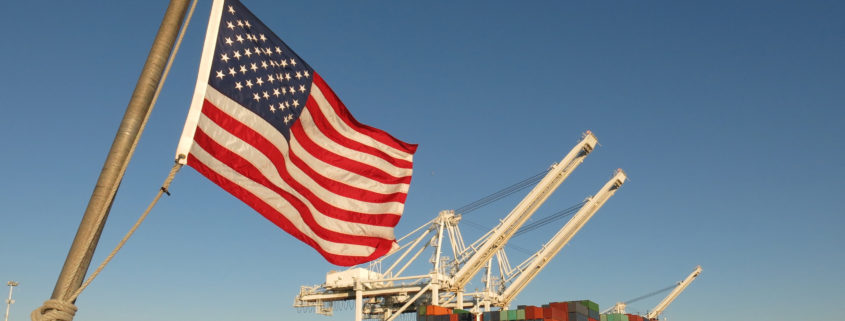Coronavirus continues to disrupt shipping supply chains; SSGA ag shippers caught in the storm
Compiled by Bruce Abbe, SSGA strategic adviser for trade and transportation
The coronavirus continues to roil global shipping and supply chains, and according to industry news reports, the outlook continues to worsen. Agricultural shippers, including Specialty Soya and Grains Alliance (SSGA) exporters, are feeling the pinch on both ends – at overseas destinations and here in the U.S. – with recovery prospects pushed out until April or beyond.
Wall Street caught its own version of the virus on Monday, with the Dow dropping 1,000 points in the afternoon over fears of the impact to global economic trade and logistics.
Freightwaves provided a timeline for the coronavirus outbreak across ocean, air, truck and rail transportation. They speculated at what point hard hit countries, like China, will need to decide if and when to switch from a containment strategy, which has seen factories shut down and people staying away from jobs and population interaction, to more of a mitigation strategy. Mitigation, because commerce and product supply – food among the most important – will need to be moved. There are risks that mitigation strategies might not be as successful, leading to unforeseen economic consequences.
A check with SSGA member shippers found the impact is beginning to hit exporters in the U.S.
One SSGA freight forwarder member noted that the immediate problem is dealing with all of the blank sailings that keep increasing. Shippers cannot get bookings until April, and those may end up getting pushed out even further if there is not a turn around. Container shipments are being rolled to later departing ships, and it’s a scramble to find a vessel going to the planned destination, with delivery dates an increasing unknown.
The worsening challenge for inland container exporters is finding available equipment. With China shutting down factories and supply chains, there has been a huge drop in import containers coming to the West Coast and then inland to Chicago, Kansas City, Minneapolis, Columbus and other key inland locations. A shortage of containers going inland means a shortage of export containers able to go back out, regardless of the destination.
China is still the source of 65 percent of the Trans-Pacific container imports to the U.S., according to IHS Markit statistics. Peter Tirschwell from the Journal of Commerce wrote last Friday that China was in the early stages of restarting manufacturing following the coronavirus outbreak. The Trans-Pacific is not the only trade lanes being hit. Alphaliner reported that the ocean carriers blanked 46 percent of its container capacity due to the virus fears. One major forwarder told Tirschwell that the extended shutdown could be a “prelude to an overwhelming surge” in demand once the factories kick back into production.
An SSGA food soybean exporter noted the timing was particularly bad for his company, which had been looking at one of its best years. With its key shipping period now being pushed out months from now, it’s going to be a challenge for both his company and its customers overseas who need reliable, timely delivery.
Boston-based container shipping data firm CargoMetrics released data last week that documented the rapid collapse of cargo shipping from China, the original source of the outbreak. Chinese imports “are totally in freefall,” said Scott Borgerson, CEO of CargoMetrics in a recent Freightwaves report.“While China’s own export trends were described as “ugly.” What happens in the next two weeks is “critical,” he said.
Shipping news sources identified the “reefer” container export trade as being among the earliest hard hit sectors. With trucking and delivery channels being shut down in China in an effort to minimize the spread of the virus, refrigerated containers that bring in perishable food products like meat, poultry, fruits and vegetables were piling up at the ports. There is only so many “reefer plugs” – power sources -available for the computerized refrigerated containers. Ocean carriers have begun diverting the containers to other ports. That too comes at a particularly bad time. After an estimated 40 percent of China’s hog population culled due to the African Swine Fever (AFS), meat exports from the U.S. to China have been on a sharp rise and one of the few U.S. bright spots in international trade.
On a more positive note, a check with an SSGA bulk grain member exporter found that the large bulk vessel grain and soy shipments appear to have not yet been hit with cancelled sailings and diversions.
“So far, the bulk vessel trade seems to be continuing without the disruptions that have hit the container trade,” says Gary Williams, vice president of marketing and business development for United Grain Corporation, a major grain trading exporter with ocean loading facilities on the Columbia River in Washington state. “Although that could change. We’re watching it closely.”
People need to eat, and the livestock and poultry herds will need to be fed. As long as the Chinese will allow the trucks to pick up and deliver soybean meal to the herds, the soybean shipments to the processing plants hopefully will continue and even pick up from the trade war decline.
However, a report out last week in World Grain confirmed what an SSGA member container feed exporter had heard – that poultry farmers in China’s Hubei and Hunan provinces have started to cull thousands of young chickens due to a shortage of feed stemming from in-country transportation restrictions due to the virus. China is reportedly releasing corn from government held stocks.
Right now, SSGA member shippers and their logistics providers are doing their best to find work-arounds to serve their customers. Visibility, particularly on estimated times of arrival, is a hard item to come by at the moment. It’s a critical time for SSGA shippers to make extra effort to maintain close communication with customers and supply chain service partners.







Leave a Reply
Want to join the discussion?Feel free to contribute!